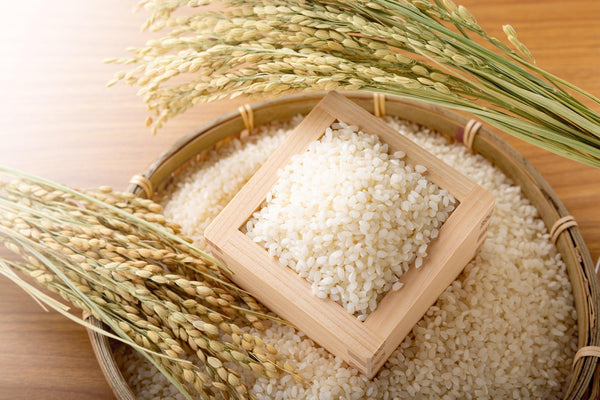
Jump to:
The extent to which rice is the staple food of Japan is clear the minute you start learning Japanese. Not only do the Japanese words for “breakfast”, “lunch”, and “dinner” literally mean “morning rice”, “lunchtime rice” and “evening rice”, but the word for cooked rice “Gohan” is literally used as a synonym for meals.
In this post, we shall look at why rice is the staple food in Japan, the different types of rice, famous rice growing areas, and how it is cultivated and manufactured. We shall also look at whether Japanese rice is healthy and suitable for everybody, look at possible substitutes, and finish by considering how best to cook and store rice.
Why Did Rice Become The Staple Food In Japan?
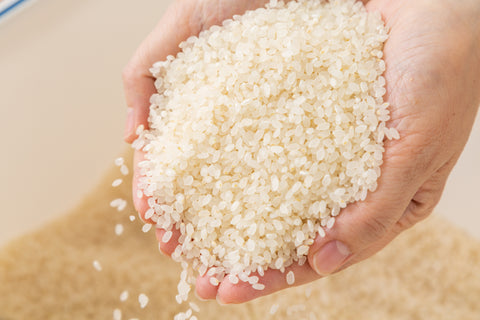
So why is it that rice became the staple food in Japan rather than other possible candidates such as wheat or potatoes? The answer to this lies in the climate.
Rice originated long ago in South-East Asia and as people started to move around carrying the seeds, many varieties of rice began to grow in different parts of the world. Rice is well suited to the warm, rainy, and water-rich climates of Asian countries, including Japan, and records of rice growing date back to the late Jomon era (around 400 BC) in the southern islands of Kyushu. Rice growing spread throughout Japan and supported the growth of its population, which although only around six million in the Nara period (710-794), grew to 30 million by the late Edo period (1603-1867), and now is roughly 120 million strong.
Rice became a staple food in Japan because it suited the Japanese climate well and could be harvested in abundance. The reason why the Japanese archipelago has been able to support such a large population is because rice is more suited to Japan's climate than other crops and can be grown in large quantities.
Different Classifications Of Japanese Rice
Before drilling down on Japanese rice, in particular, we should perhaps consider the general classifications of rice. Rice is most often classified according to the length of its grain, as long grain, short grain, or medium grain. Each type has its specific uses in different cuisines and the results of trying to substitute one for the other are rarely successful. For example, long-grain rice is ideal for dishes where you want the grains to be distinct and not stick to your utensils, such as pilaf and biryani. Using sticky short-grain Japanese-style rice for such foods will create something different and generally less appealing altogether.
Japanese dishes almost exclusively use short-grain rice, although medium-grain rice may be used in some situations. Although Japanese people may cook some dishes using long-grain rice, this would not generally be considered Japanese food.
Different Types Of Japanese Rice
In this section, we will look at the different types of Japanese rice (for which the cultivar has the general name Uruchimai), starting with white rice, which is the most commonly eaten variety.
Hakumai (White Rice)
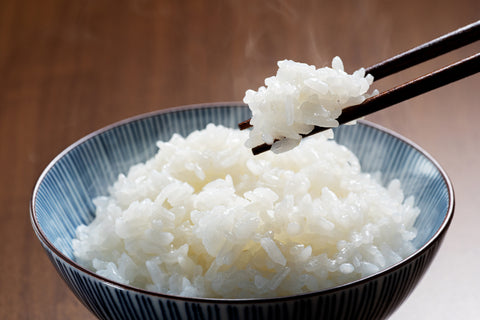
Hakumai (also called Seihakumai) is the preferred rice for the vast majority of the Japanese population. The husk, bran, and germ of the rice are removed, and the grains are polished. Japanese rice is sometimes referred to as “sticky rice” outside of Japan, and the reason that it is stickier than other types is because it has a high starch and moisture content. The starch itself contains amylose and amylopectin. The stickiness in the rice comes from having a small amount of amylose and a large amount of amylopectin. Hakumai is less nutritious than other types of rice because most of the nutrients are found in the outer layers, which are removed. It should be noted that sushi rice is not a distinct type of rice, but Hakumai flavored with Sushi vinegar. If you are interested in making Sushi rice, you might like to check out this recipe.
Genmai (Brown Rice)
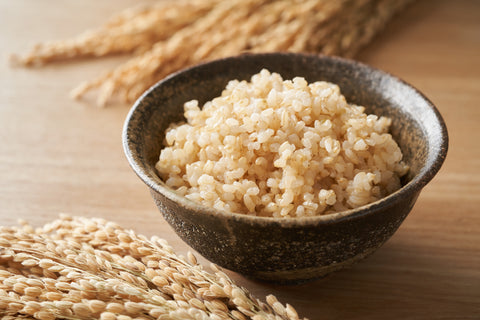
The word Genmai comes from the Chinese characters “玄” meaning “dark” and “米“ meaning rice. It is dark in the sense of having a beige color because it is unpolished. As the bran and germ, where most of the nutrition is included, is not removed, Genmai is healthier than Hakumai. Despite these health-giving properties, it lacks the popularity of Hakumai, due to its tougher texture.
Hatsuga-Genmai (GABA Rice)
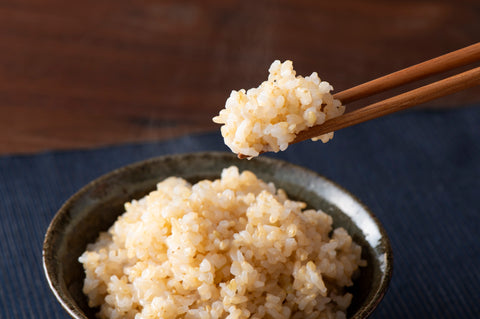
Hatsuga-Genmai is literally brown rice that has been allowed to germinate. When plant seeds sprout, nutrients are condensed and new nutrients are created, making the rice even more nutritious than brown rice. In addition, it is noted that sprouting greatly increases the amount of "GABA" (gamma-aminobutyric acid), hence the name “GABA rice”. GABA is lauded as having numerous health benefits, such as relaxation/stress relief, stimulating the brain, inhibiting the increase of triglycerides, and stabilizing high blood temperature.
Haigamai
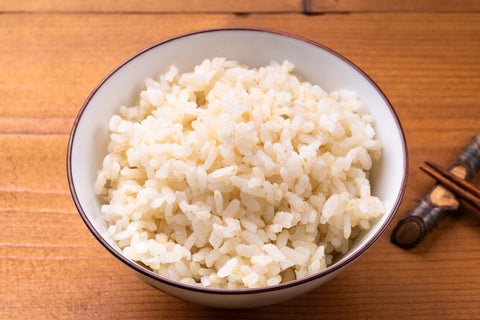
Haigamai aims to give you the best of both worlds, with the soft texture of white rice while still being highly nutritious. It does this by using a special form of processing that removes the bran layer of the rice, but retains its Haiga (husk), hence the name Haigamai.
Buzukimai
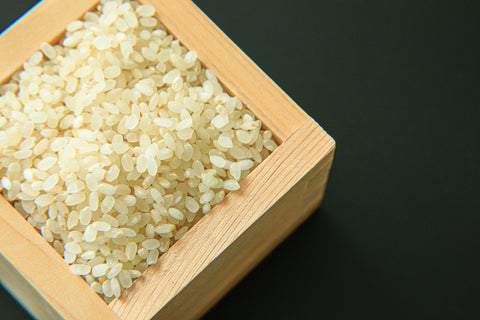
Buzukimai is way of selecting different degrees to which the germ and hull are removed from white rice. For example, this can be 30% removed (Sanbu-zuki) or 70% removed (Shichibu-zuki), which is actually fairly close to white rice. This type of rice allows you to make a trade-off, based on your priorities, between texture and nutrition.
Mochigome (Glutinous Rice)

Whereas the above varieties of rice would come under the category of Uruchimai, Mochigome is a completely different beast. Mochigome, which tends to be eaten on special occasions rather than as an everyday rice, is glutinous and chewier for use in Mochi rice cakes and Wagashi (Japanese sweets). It is also used in Sekihan (literally “red rice”), where the glutinous rice is mixed with Azuki beans, which gives it a reddish color.
What Are The Main Rice Growing Areas In Japan?
In 2023, the total production of rice in Japan was over 8 million tons. So, what are the leading prefectures when it comes to producing rice in Japan? According to data from the Ministry of Agriculture, Forestry, and Fisheries for 2023, the top rice-growing prefecture in Japan was Niigata with 7.7% of total production, followed by Hokkaido and Akita Prefecture with 7.3% and 6.1%, respectively.
This suggests that despite rice cultivation originating in the warm island of Kyushu, it is actually the cooler northern prefectures that are more suited to growing rice.
How Is Japanese Rice Cultivated And Processed?
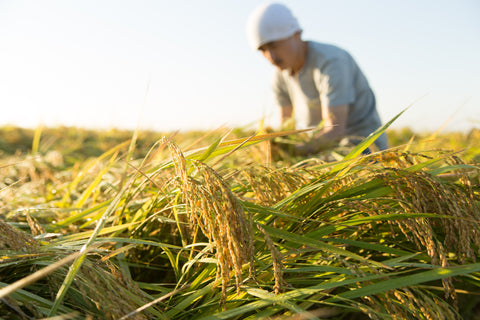
The process of rice production, from paddy field to dinner table involves a labor of love across all seasons, and Japan’s four distinct seasons are one of the reasons for its high production levels. The process starts in Spring every year.
Spring
In spring, the fields or rice paddies are prepared to welcome the new seedlings, and there needs to be plenty of water. A lot of rice is planted in May and June, and festivals are held throughout the country to hail and bless the beginning of the rice season.
Summer
As things begin to warm up in the summer, and with the advent of the rainy season in late June and early July, the rice plants grow with an exuberance throughout this period, and the fields are adorned with bright green plants.
Fall
As temperatures finally cool off in the fall, the fields have turned into waves of golden rice, and water is drained from the paddies to make it easier to harvest the rice, the process of which is normally carried out using a harvester. The rice is then dried, and the hull is removed.
Winter
At this point, we have brown rice. Most Japanese rice is polished to make white rice, and this process is carried out at factories during winter, before the rice is shipped to wholesalers, before going onto retailers, and finally into homes.
Is Japanese Rice Healthy?
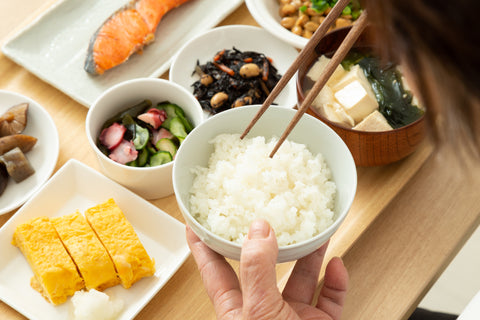
Japanese rice consumption per capita has approximately halved over the last 50 years. There are a number of reasons for this including the growth of international travel and exposure to a wider range of food types.
Another reason that has come to the fore in more recent years, however, is the popularity of low-carbohydrate diets. While it is true that fewer Japanese people are overweight than their Western counterparts, there are other factors than diet for this, including genetics. Given this shift away from rice, is Japanese rice healthy?
Although rice does have a high carbohydrate content, short-grain rice tends to have a lower glycemic index, leading to fewer blood sugar spikes, than other types of rice. It also contains a high proportion of vitamins and minerals and the fact that it is commonly steamed rather than boiled means that Japanese rice tends to preserve its nutrient content.
However, despite its lower glycemic index than other types of rice, over-consumption can still put you at risk of type-2 diabetes, so as in most things food-wise, moderation is the key to maintaining a healthy diet.
Possible Substitutes For Japanese Rice
What if you want to cook Japanese food but don’t have access to Japanese rice? Is there anything else you can use instead? Generally speaking, the shorter the grain the better. Basically, using long-grain rice for Japanese dishes is a non-starter, as it will lack the stickiness that suits Japanese cuisine.
If you can’t find short-grain rice, then medium-grain rice will probably be just about acceptable at a pinch.
If you can get hold of Korean rice, this will suffice for some dishes. Like Japanese rice, it is short-grained and sticky. The major difference is that Korean rice has more of a nutty quality. This probably excludes its use for sushi, but for dishes where the taste of the rice is less important, such as Donburi or Japanese curry, Korean rice will be a good substitute.
How To Cook Japanese Rice?

In this section, we will look at how best to cook Japanese rice, firstly using a rice cooker, and then looking at alternatives if you don’t have access to one.
After rinsing the rice, many recipes suggest soaking the rice for about 20 minutes. This is to absorb extra water. An alternative to this is to add a higher ratio of water once you start cooking. If you soak the rice, you should be looking at a 1:1 ratio of rice to water. However, you can probably get away without soaking the rice if you use a 1:1.2 ratio, as this will allow the rice to absorb more water during the cooking process.
Press the Start button and once it is cooked, allow the rice to steam for about 10 minutes before serving. Simple as that (check out this article for more information)!
If you don’t have a rice cooker, though, you can cook the rice in a pot. Steps are similar to using a rice cooker, but of course, there is no button to press. After bringing it to boil over a medium heat, cover the pot with a lid and cook on low for around 8-10 minutes. Once you confirm the water is completely absorbed, remove the lid and allow it to steam. See this article for more information.
If you want to go ultra-convenient, there are also some microwavable options that allow you to enjoy rice almost instantly, such as this pack of three portions of microwavable rice from Sato-no-Gohan.
How To Store Cooked Japanese Rice?
What do you do if you have cooked rice but can’t eat it all in one sitting? A common impulse is to put it into a Tupperware container and refrigerate it, but the starch molecules in rice break down when refrigerated, and this leads to dry, hard, rice. A better approach is to put the rice in plastic wrap and allow it to cool (this is very important). Then place in the freezer and freeze until you need it again.
Rice - Still The Unrivalled Staple Food Of Japan

Despite the decline in rice consumption among Japanese people over the years as our eating habits have become more globalized, rice remains the key staple food in the Japanese diet. It is eaten by nearly all Japanese people at least once a day, and it is not uncommon for it to be eaten for all three meals.
How often do you eat rice? Do you eat exclusively Japanese rice, or do you enjoy other varieties as well? Let us know in the comments.


0 comments